Summary of Luca Signorelli
Signorelli is undoubtedly most revered for his rendering of figures in action and his unparalleled mastery of the human anatomy which came to full fruition with his world renowned Orvieto frescoes. Such was his reputation, he formed part of an elite group of artists summoned by Pope Sixtus IV to decorate the walls of the Sistine Chapel. Possibly because of the ignominy of being unceremoniously replaced by Raphael on a subsequent Vatican Palace commission, his later works are - with one or two outstanding exceptions - considered comparatively fatigued and pedestrian (and likely finished by the hands of assistants). But for his major works, he was, in the words of Giorgio Vasari, an artist who "with his profound mastery of design, particularly in nudes, and with his grace in invention and in the composition of scenes, opened to the majority of craftsmen the way to the final perfection of art".
Accomplishments
- Signorelli's masterpiece of High Renaissance painting was the series of frescoes for the Orvieto Cathedral that illustrated the end of the world and contained several magnificently realized nudes. Commenting on the Orvieto frescoes, the art historian James Beck wrote, "In Signorelli's vision, the world is composed of beautiful young men and women, muscular, strong, thick-limbed, with well-formed hands and distinctive fingers [they] are convincingly three-dimensional and occupy the spaces they create by their fleshy presence".
- As a pupil of Piero della Francesca, Signorelli had learned about solid figures and his master's sensitive handling of light. Signorelli differed significantly from della Francesca, however, in the way he represented figures in action and the skill with which he blended them together into complex compositions. The nudes for which he is most famous typically populate densely crowded narratives that show off Signorelli's consummate handling of perspective and symmetry.
- Signorelli displayed a mastery and invention in anatomical drawing that was unequalled and only later matched by Michelangelo. Indeed, his seated nude in Last Acts and Death of Moses in the Sistine Chapel, antedates the Ignudi, the collective name (derived from the Italian, "nudo", or "nude", in English), that Michelangelo gave to his 20 nude figures on the ceiling of the chapel, painted a quarter of a century later.
- Given the predominance of his skill in anatomical renderings, color is generally relegated to a subsidiary role in the analysis of Signorelli's compositions. But this belies the fact that he employed a unique, rich, and dramatic colouring that brought an added progressive quality to his frescoes. Indeed, Beck argues that his Orvieto frescoes "would have had a far more powerful, even inevitable impact on other artists were they not located in a provincial centre" and that if they appeared to some critics as "old-fashioned", that was only because they were "so quickly followed by the frescoes in the four Raphael Rooms and Michelangelo's Sistine Chapel frescoes".
The Life of Luca Signorelli
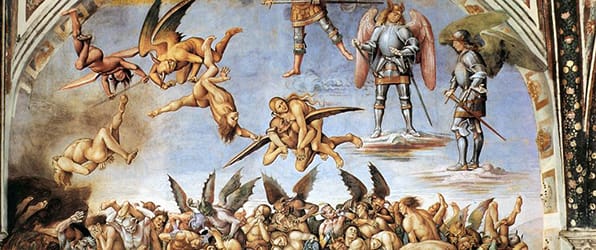
Giorgio Vasari positioned Signorelli as a momentous figure in the development of Renaissance art, "he showed the way to represent nude figures in painting so as to make them appear alive", wrote Vasari, and, "as anyone can see", he had a profound impact Michelangelo's Last Judgment in the Sistine Chapel.
Important Art by Luca Signorelli
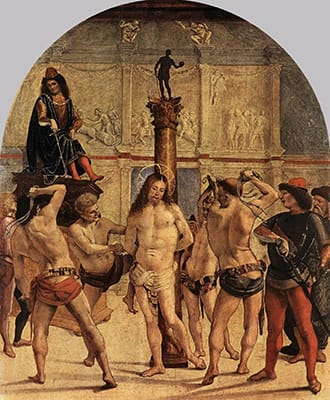
The Flagellation of Christ
This, believed to be Signorelli's earliest surviving work, was commissioned by the one-time "Confraternita dei Raccomandati" fraternity of the Church of Santa Maria del Mercato in Fabriano, Italy. It was intended to be included in processional demonstrations of public flagellation, and was thus requested by the members of the fraternity. The image directly references the biblical passages of John 19:1, when Pilates had sentenced Christ to be crucified, but not before being flogged by Roman soldiers while tied to a post. This work is believed to be one side of a double-sided panel, with the second side presenting The Nursing Madonna (as the fraternity also carried out philanthropic work to help orphaned and abandoned children). At some point between the sixteenth and nineteenth centuries, the two sides were separated.
Here, as art historian Maud Cruttwell notes, we see the influence of Signorelli's master, Piero della Francesca, particularly in terms of the command of perspective and symmetry, as well as the "firm, clear outlining of the nude figures, their solid modelling, and in the broad massing of the shadows". Cruttwell adds, however, that, "Even more apparent is the influence of Antonio Pollaiuolo, in the great realism with which the subject is treated, and in such superficial resemblances as the type of head of the executioner who binds the hands of Christ, and the characteristic striped loin-cloths".
Yet at the same time, Signorelli was beginning to set himself apart from the influences of della Francesca and Pollaiuolo, especially in his use of vibrant colors, and the more dynamic sense of action. Cruttwell argues in fact that "It would be impossible to overrate the excellence and beauty of drawing in the splendid swing of the bodies, the flexibility of the limbs, the sinewy elasticity of the leg muscles, and above all, the subtle suggestion of muscular movement under the loose skin of the backs".
Tempera on panel - Pinacoteca de Brera, Milan, Italy
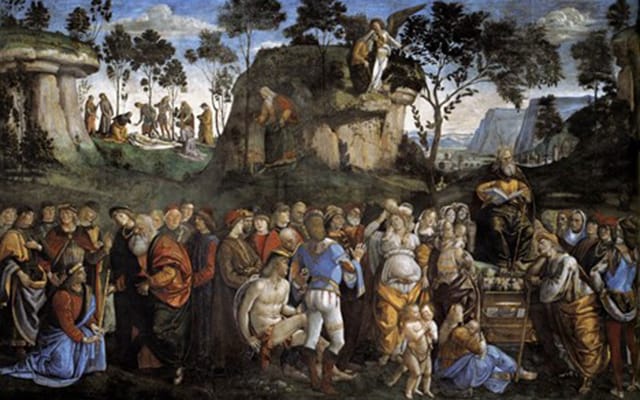
The Testament and Death of Moses
In this fresco, Signorelli presents five simultaneous events from the end of the life of Moses, which can be read from right to left. Moses is seen on the right-hand side, reading covenants of the Lord to a large group of followers who fill the entire bottom half of the image. Moses sits upon the ark of the covenant, placing him slightly above the crowd. The Ark is open, displaying the jar of manna and two tables of the law inside. Then, atop Mount Nebo at the center of the background, Moses is depicted with an angel who allows him to see the far-off Promised Land, even though, as the angel informs Moses, only his descendants, not he, will ever arrive there.
Lower down the mountain, Moses is shown descending towards his death. At the left-hand side of the foreground, he is shown, at the age of 120, appointing Joshua (who kneels before him) as his successor, to take over the task of leading the Israelites to the Promised Land. Finally, to the upper-right of the background, Moses's followers are shown mourning his passing in Moab. Here, he lays amidst the group, enshrouded in white linen. At the far left is the cave in which he will be entombed.
This fresco is one of several in the Sistine Chapel that depict the major episodes in the life of Moses. It is believed that Signorelli collaborated on this work with his friend, Bartolomeo della Gatta, with the more dynamic figures most certainly being executed by Signorelli. One of these figures, a seated nude youth in the center of the foreground, is believed (in fact, generally accepted) to have served as a reference for the 20 nude figures - what Michelangelo called the Ignudi - painted on his famous chapel ceiling 25 years later.
Fresco - Sistine Chapel, Vatican
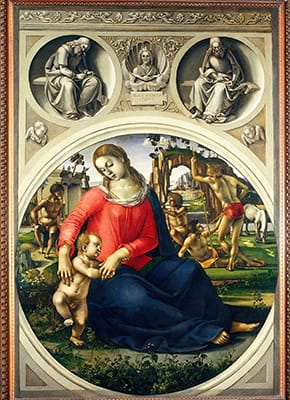
Madonna and Child with Ignudi (aka The Medici Tondo)
This boldly-colored work, commissioned by either Florentine de facto ruler Lorenzo de Medici, or banker and politician Lorenzo di Pierfrancesco de Medici, presents the Virgin Mary, wearing a red dress and blue robe, and sitting on the ground in a pastoral outdoor setting (with classical architectural features in the background) with the Christ Child at her side. He is nude, standing on one foot, with his right leg raised, being supported by his mother, holding her left hand with both of his, and her right hand gently supporting his side. In the mid-ground, Signorelli included a grazing horse, and four young men, naked except for loincloths. The round presentation (tondo) is a trompe-l'oeil painting of carved stone, with, at the upper left and right corners, the figures of two prophets in the process of writing, and between them, Saint John the Baptist.
The nudity of the Christ Child as well as of the background figures, not only shows off Signorelli's skill in painting the human form but can also be interpreted as a way of including the idea of worldly human nature into this religious work. With this painting, Signorelli pioneered the inclusion of nude figures in representations of the Holy Family, and Michelangelo followed suit by doing the same, for instance, in his Tondo Doni (1504-06). (Other similarities exist between these two works, including the tondo format, and the placement of the Virgin Mary directly on the ground.)
Art historian James Beck writes, Madonna and Child "chronicles Signorelli's adherence to classical models, especially for the nudes in the background of the tondo, with its fictive marble frame superimposed on a rectangular picture". He surmises from the painting that Signorelli "must have been a student of ancient sarcophagi as well as of freestanding statues and very likely also knew quite a bit about Roman sculpture and Greek pottery. At the same time, he was aware of the sculpture of Donatello and Andrea del Verrocchio. Landscape painting, as with Michelangelo, had little interest for Signorelli, although in the Uffizi Madonna the flowers and plants are presented affectionately, and in the rocky cliff, open in the middle like a gigantic arched bridge, already a familiar motif in the art of Andrea Mantegna, he expanded his formal vocabulary to meet the fierce competition in Florence".
Oil and tempera on wood panel - Uffizi Gallery, Florence, Italy
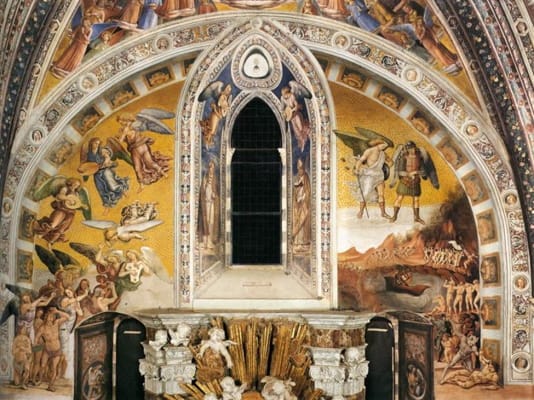
Last Judgment
This fresco series for the Orvieto Cathedral, and its companion series The Apocalypse, are considered Signorelli's masterpieces. While The Apocalypse occupies three large lunettes near the entrance to the chapel, Last Judgment was painted on the opposite vault and the walls surrounding the altar. Both works feature crowded compositions with several nude figures in a variety of poses, demonstrating Signorelli's sublime skill in representing the human form and musculature.
Art historian, and contemporary of Signorelli, Giorgio Vasari, enthused about the work, "all the scenes of the end of the world with bizarre and fantastic invention - angels, demons, ruins, earthquakes, fires, miracles of Antichrist, and many other similar things besides, such as nudes, foreshortenings, and many beautiful figures; imagining the terror that there shall be on that last and awful day". The art historian Sara Nair James has also pointed out that these compositions also strongly indicate literary influences, particularly Dante's poem Divine Comedy (especially the second part, Purgatorio), Jacobus de Voragine's Golden Legend, as well as Apocryphal Gospels and Roman Liturgical texts.
Vasari noted that both The Last Judgment and The Apocalypse greatly influenced Michelangelo; especially so in terms of the crowded compositions and Signorelli's nude human figures. Of his influence on his peers generally, Vasari wrote "Luca Signorelli, an excellent painter, of whom, according to the order of time, we have now to speak, was more famous throughout Italy in his day, and his works were held in greater price than has ever been the case with any other master at any time whatsoever, for the reason that in the works that he executed in painting he showed the true method of making nudes, and how they can be caused, although only with art and difficulty, to appear alive".
Fresco - Chapel of S. Brizio in the cathedral of Orvieto, Italy
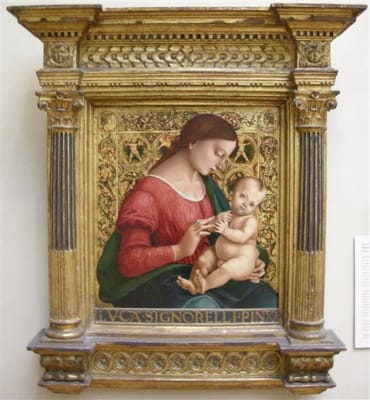
Madonna and Child
Signorelli produced many ornate "gold" works in his later career. This piece, which presents a richly colored, half-length portrait of the Virgin Mary with the Christ Child on her lap, is presented against just such a decorative golden background. It was given as a gift to Signorelli's youngest daughter, Gabriella, on April 10, 1507. The two likely reasons for the gift was to either mark the series of family tragedies - including the deaths of Gabriella's brother Antonio and sister Felicia due to the plague in 1502, followed by the death of her mother in 1506 - or that it was a painted to commemorate the birth of one of Gabriella's three daughters.
Gretchen Wold, Senior Collections Manager at Metropolitan Museum of Art in New York said of the painting that "The grotesque decoration, athletic putti, and invented Roman coins or medals which comprise the exceptional background relate to Signorelli's antiquarian interests and have analogies in his fresco cycle of 1499-1503 in the cathedral of Orvieto". In 1910, the famous English painter and art critic Roger Fry described the painting as "great and profoundly original", and that "one not only gains intense satisfaction from the marvelous drawing of the gold decoration, with its intreccia of aggressive putti and scroll-work, but one realizes that the figures of the Madonna and Child maintain their due predominance by the unparalleled amplitude and simplicity of their forms". Fry argued that the color, too, "with its suggestion of archaic and Byzantine originals" was in fact "one of the most daring and successful experiments in Italian art".
Oil and gold on wood - The Metropolitan Museum of Art, New York City
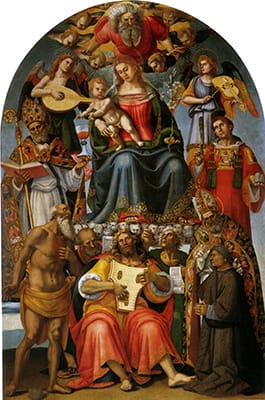
Madonna and Child with Saints
This, Signorelli's last completed painting (before his death in 1523), is a Holy Conversation composition (or Sacra Conversazione). The Virgin sits in the upper center of the work, upon a throne that appears to be supported by, and/or adorned with, human heads or skulls. On her lap is a naked Christ Child. She is surrounded by several saints engaged in various activities (such as gazing at Mary with admiration, playing instruments, kneeling in prayer, and reading), as well as two angels to either side of Mary's head, playing instruments. At the very top of the image, God himself, along with several cherubs, is seen looking down from the heavens. These figures fill Signorelli's packed frame.
In the final two or so decades of his career, his works (including The Trinity, the Virgin and Two Saints (1510) and Communion of the Apostles (1512)) became notably more conservative and traditional, with many, including Madonna and Child with Saints, relying on a more simplistic bilateral symmetrical composition than one saw in his best earlier works. Moreover, the quality of the rendering of the figures is markedly less impressive than in his earlier works, indicating that significant portions of these later works were delegated to his assistants.
The Washington National Gallery of Art states: "In the last twenty years of his career, apart from some other evocative masterpieces like the Lamentation over the Dead Christ for the church of Santa Margherita in Cortona (Museo Diocesano, Cortona) of 1502, and the frescoes in the Palazzo del Magnifico in Siena (1509), Signorelli produced mainly routine works, sometimes weary and often repetitive, whose execution was increasingly delegated to his well-organized workshop". That having been said, Michelangelo's held this work in high esteem; a view supported by Vasari who argued that the painting was final proof of "the considerable importance of [Signorelli's] contribution to the development of Italian High Renaissance painting".
Tempera on panel - Museo di Arte Medievale e Moderna, Arezzo, Italy
Biography of Luca Signorelli
Childhood
Little is known of the early life of Luca d'Egidio di Ventura de' Signorelli - more widely known simply as Signorelli. He was likely born around 1450, in Cortona, a small-town bordering Tuscany and Umbria. His maternal uncle was painter Lazzaro Vasari, the great-grandfather of art historian and painter Giorgio Vasari. It is then highly likely that he was engaged in artistic pursuits from early childhood. It is also rumored that from a young age he visited gravesites to exhume and dissect bodies to study human anatomy. If this part of his legend is true, it would help account for his unique talent for representing the naked human figure.
Education and Early Training
In the 1460s, Signorelli undertook an apprenticeship with Early Renaissance painter, Piero della Francesca. The famous mathematician, Fra Luca Pacioli, called Signorelli "a worthy disciple" (of della Francesca) as he was quick to learn the principles of mathematics, geometry, and perspective that were central to his master's practice. During his apprenticeship, Signorelli befriended fellow pupil, and future Renaissance painter and architect (and widely admired for his skill at foreshortening) Melozzo de Forli. Around 1470, Signorelli married Gallizia di Piero Carnesecchi, with whom he had three sons, Polidoro (a future painter and builder), Antonio (assistant to his father), and Pier Tommaso, and two daughters, Gabriela, and Felicia. It is known that in 1472 Signorelli was working in the city of Arezzo, about fifteen miles from his hometown of Cortona, and that in 1474 he also worked in the nearby Città di Castello.
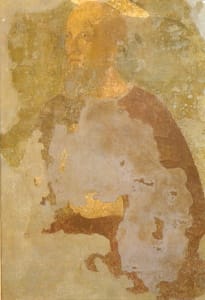
A poorly preserved fresco fragment in Castello, which is dated 1474, is thought to be Signorelli's first surviving work. The Washington National Gallery of Art (WNGA) states, in fact, that, "In the second half of the 1470s Signorelli must have had contacts with the cultural climate of the court at Urbino, where Bramante, Francesco di Giorgio, and Justus of Ghent were working, and also with the Florentine art world, dominated in that period by Antonio and Piero del Pollaiuolo and Verrocchio's workshop. He enjoyed a particularly close relationship, however, with Bartolomeo della Gatta, the great Camaldolese painter and book illuminator who may well have been active at the Urbino court as well as in Arezzo and Cortona". His work also reflects at the influence of the Pollaiuolo brothers, especially in terms of their "scientific-like" search for naturalism, which emerges in his work from this early period.
Mature Period
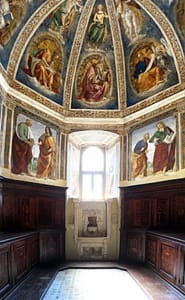
Historian James Beck writes that "Signorelli's training and early career are hazy because of the limited number of early pictures. The small, signed Flagellation, made originally as a processional banner and once backed by a Madonna and Child (now separated), was for a church in Fabriano and is probably one of his earliest surviving works". But, dated around the same period, between 1477-80, Signorelli properly announced himself when he painted the San Giovanni Sacristy in Loreto's Holy House. He was assisted on the commission by Pietro Perugino and della Gatta. Signorelli frescoed the eight segments of the vaulted ceiling with eight musical angels, the four Evangelists alternating four Doctors of the Church, and five pairs of Apostles in conversation. Commenting on the frescoes, The WNGA states, "It is here that the young [he was still only about thirty years of age] Signorelli's work probably reaches its highest point, with an open grandeur and power [...] enlivened by a complex and elegantly refined play of gestures as well as a strong emotional charge".
Also in 1482, Signorelli was commissioned to paint the doors of a wardrobe frontal in Lucigniano. Overlapping the Loreto frescoes and the Lucigniano commission, Signorelli worked in Rome (between 1478-84). He first assisted in the decoration of the lower walls of the Sistine Chapel but with his reputation in sharp ascendency, Pope Sixtus IV invited him to paint a single fresco, Testament and Death of Moses, (in the Sistine Chapel) which he completed, almost entirely in his own hand, in 1482.
By the time he returned to Cortona in 1484, Signorelli's reputation was secured. According to arts writer Roderick Conway Morris, "this is also the point in his career when Signorelli's new race of boldly modeled and candidly presented nudes - which were to have such a telling effect not only on Michelangelo, but also on Raphael and other artists of the High Renaissance - start to become a regular presence in his works". Signorelli remained based in Cortona for the rest of his life, although he travelled periodically to Città di Castello, Volterra and Siena. It is also recorded that, in 1485, he was commissioned to decorate an altarpiece in Spoleto; though this work (which was thought to be incomplete in any case) has been lost.
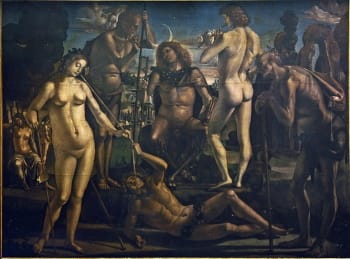
Signorelli was also active in politics; he was elected to the Council of 18 in Cortona in 1488 and held high-ranking positions on the magistracy of Cortona up until his death (in 1523). But around 1490 he visited Florence, where Lorenzo de' Medici commissioned him to paint The Education of Pan (1490). The painting features the half-human half-goat figure of Pan who sits enthroned in the centre of the picture surrounded by fully human figures. Pan is flanked by two elderly male figures who hold staffs while a youthful male stands before him playing a pipe while another reclines at Pan's feet. But the outstanding feature of the work was the inclusion, in the foreground, of the young naked woman holding a long pipe. (Sadly, the painting was destroyed by allied bombing in WWII.)
In 1491 Signorelli painted The Annunciation for the Town Hall (Galleria Communale) of Volterra. Also in 1491, he was invited to sit on a panel to judge the best designs for the new facade of the Florentine Cathedral. Although he declined the invitation, the fact that Signorelli was invited at all was proof of his standing within the Florentine Renaissance. Indeed, arts editor Kathleen Kuiper points out that, "his interest in dramatic action and the expression of great muscular effort [made] him as an essentially Florentine naturalist". In 1498 Signorelli, with assistance from his friend Francesco di Giorgio, painted the altarpiece for the Bichi Chapel in Sant'Agostino (complementing an existing sculptured predella by Francesco di Giorgio). In 1498 he also accepted a commission to decorate the Monastery in the Siena province of Monteoliveto Maggiore (complementing existing frescoes by Il Sodoma) for which he produced eight scenes from the life of Saint Benedict.
Between 1499-1503 he worked on a series, which for many represent his greatest masterpieces, for the Orvieto Cathedral. Tableaux including, The Preaching of the Antichrist, is thought to feature portraits of prominent figures of the Renaissance age including Raphael, Christopher Columbus, Cesare Borgia, Dante and, indeed, a self-portrait of the artist himself. Michelangelo was so impressed by the Orvieto series he used them as a reference point when painting The Last Judgement in the Sistine Chapel.
Late Period and Death
In 1502, Signorelli lost two children, his daughter Felicia, and son, Antonio, to the plague. Vasari wrote that Signorelli, "heart broken as he was, had [Antonio] stripped naked, and with the greatest firmness of soul, without lamenting or shedding a tear, portrayed him, to the end that, whenever he might wish, he might be able by means of the work of his own hands to see that which nature had given him and adverse fortune had snatched away". The drawing of Antonio's corpse served as the basis for his tempera on panel work, Lamentation over the Dead Christ, painted that same year. In 1508, Signorelli was once again invited to the Vatican, by Pope Julius II, along with Perugino, Pinturicchio, and Il Sodoma, to paint several large rooms in the Vatican Palace. However, shortly after the group began work, the Pope dismissed them to offer the entire commission to Raphael.
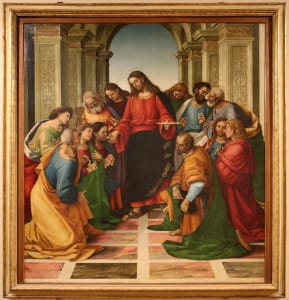
Art historians, including Ralph Fastnedge, Nicola Fruscoloni, and Maud Cruttwell, agree that from about 1510 Signorelli's works declined in quality, becoming more "weary" and "repetitive", and it is evident that he delegated an increasing amount of his work to his assistants. But as Beck writes, among his last works "where a noticeable decline in quality is undeniable, the Institution of the Eucharist [1512] retains the originality of his previous efforts. Christ, standing in the centre high in the picture, is framed by the finely decorated piers and the arch of a Renaissance structure, open to the pale sky. He offers the holy wafer to the Apostles, who form a spatial funnel, revealing a multicoloured marble floor. Judas, perhaps the finest figure in the painting, is subtly separated from the others; he turns away from Christ, putting the Host in a money sack where presumably he stores the pieces of silver, a sad and remorseful image".
According to Vasari, in the final years of his life, Signorelli "worked more for pleasure than for any other reason, as one who, being used to labor, neither could nor would stay idle". In 1520, he began work in Arezzo on a fresco titled the Baptism of Christ in the chapel of the palace of Cardinal Passerini. Whilst working on this fresco Signorelli suffered a stroke and became partially paralyzed. Despite his ill health, he continued to accept commissions until his passing in 1523 (he was by then in his eighties). On October 16, 1523, he was buried in the church of San Francesco in Cortona next to his wife (who had been buried there in 1506).
Vasari was full of admiration, not just for the artist, but for Signoretti the man. He wrote: "Luca was a man of most excellent character, true and loving with his friends, sweet and amiable in his dealings with every man, and, above all, courteous to all who had need of him, and kindly in teaching his disciples. He lived splendidly, and he took delight in clothing himself well. And for these good qualities he was ever held in the highest veneration both in his own country and abroad".
The Legacy of Luca Signorelli
Signorelli is remembered most for the stylistic daring he showed in rendering the naked body. His works were imbued with a sense of human dynamism that far surpassed the more static works of his teacher, Piero della Francesca, and those of esteemed contemporaries such as Donato Bramante and Pietro Perugino. Indeed, through his demonstration, and exceptional understanding, of human anatomy and musculature in motion, he had put down a marker in the development of High Renaissance art.
Signorelli's active nude bodies directly influenced Michelangelo (as can be seen, for example, in Michelangelo's frescoes on the ceiling of the Sistine Chapel) as well as many other artists of the subsequent generation of Italian Renaissance painters, not least Raphael. As art historian Giorgio Vasari put it, Signorelli "encouraged all those who have lived after him". Art historian Raya Yotova summed up by saying: "From his early years, Signorelli presented a unique style that combined the vibrant linear dynamism of Pollaiolo and Verrocchio with [a] calm spatiality [...] His style possesses a great tension that is evident in the tendency of the figures to transcend the limit of perspective indicated by the frame of the work", while adding that many of Signorelli's works demonstrated "passionate expressive violence [and] a finely tuned "iconographic complexity".
Influences and Connections

-
![Piero della Francesca]() Piero della Francesca
Piero della Francesca - Benedetto Bonfigli
- Fiorenzo di Lorenzo
- Antonio del Pollaiuolo
- Piero del Pollaiuolo
- Bartolomeo della Gatta
- Francesco di Giorgio
- Melozzo de Forli
- Bartolomeo della Gatta
- Francesco di Giorgio
- Melozzo de Forli
Useful Resources on Luca Signorelli
- Luca Signorelli: Drawings & PaintingsBy Raya Yotova
- Luca Signorelli: The Complete PaintingsOur PickBy Tom Henry and Laurence Kanter
- Luca Signorelli: The San Brizio Chapel, Orvieto (The Great Fresco Cycles of the Renaissance)Our PickBy Jonathan B. Riess
- How Fra Angelico and Signorelli Saw the End of the WorldBy Creighton E. Gilbert
- The Renaissance Antichrist: Luca Signorelli's Orvieto FrescoesOur PickBy Jonathan B. Riess
 Ask The Art Story AI
Ask The Art Story AI







